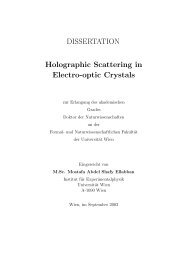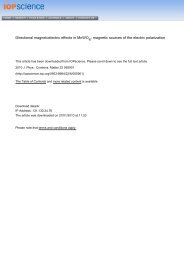PhD (PDF) - Universität Wien
PhD (PDF) - Universität Wien
PhD (PDF) - Universität Wien
Sie wollen auch ein ePaper? Erhöhen Sie die Reichweite Ihrer Titel.
YUMPU macht aus Druck-PDFs automatisch weboptimierte ePaper, die Google liebt.
3.1. EIGENSCHAFTEN DES NEUTRONS 31<br />
berechnen sich die Intensitäten zu<br />
Ψ± = A1e ıS1/� ± A2e ıS2/�<br />
I± = |Ψ±| 2 = A 2 1 + A 2 2 ± A1A2<br />
2<br />
(3.3)<br />
cos(∆Φ). (3.4)<br />
Unter Zuhilfenahme des Formalismus der Kohärenzfunktionen wird in Kapitel 4 gezeigt, wie,<br />
durch Messung der Intensitäten I±(∆Φ) am Ausgang des Interferometers auf die Kohärenzeigen-<br />
schaften des Teilchenstrahls geschlossen werden kann. In Kapitel 6 erfolgt dann eine Diskussion<br />
und Präsentation der experimentellen Ergebnisse zur Bestimmung der Kohärenzcharakteristik<br />
zweier verschiedener Kleinwinkelstreuanlagen für kalte Neutronen.<br />
3.1 Eigenschaften des Neutrons<br />
Das Neutron wurde von Ernest Rutherford im Jahr 1920 [65] postuliert und 1932 von James<br />
Chadwick bei der Untersuchung der Kernreaktion 9 4B + 4 2He −→ 12<br />
6 C + 1 0N experimentell nach-<br />
gewiesen. In der Veröffentlichung seiner Entdeckung schreibt er [66]: ”These results, and others<br />
I have obtained in the course of the work, are very difficult to explain on the assumption that<br />
the radiation from beryllium is a quantum radiation, if energy and momentum are to be con-<br />
served in the collisions. The difficulties disappear, however, if it be assumed that the radiation<br />
consists of particles of mass 1 and charge 0, or neutrons. The capture of the α-particle by the<br />
Be 9 nucleus may be supposed to result in the formation of a C 12 nucleus and the emission of<br />
the neutron. From the energy relations of this process the velocity of the neutron emitted in<br />
the forward direction may well be about 3 × 10 9 cm/s. The collisions of the neutron with the<br />
atoms through which it passes give rise to the recoil atoms, and the observed energies of the<br />
recoil atoms are in fair agreement with this view. Moreover, I have observed that the protons<br />
ejected from hydrogen by the radiation emitted in the opposite direction to that of the exciting<br />
α-particle appear to have a much smaller range than those ejected by the forward radiation.<br />
This again receives a simple explanation of the neutron hypothesis.” Kurze Zeit später zeigt<br />
Werner Heisenberg [67, 68], dass es sich bei diesem neuen Teilchen um ein Elementarteilchen<br />
(Nukleon) handelt und formuliert das uns geläufige Protonen-Neutronen-Modell des Atomkerns.<br />
Das heute akzeptierte Standardmodell der Elementarteilchen beschreibt das Neutron als Baryon,






